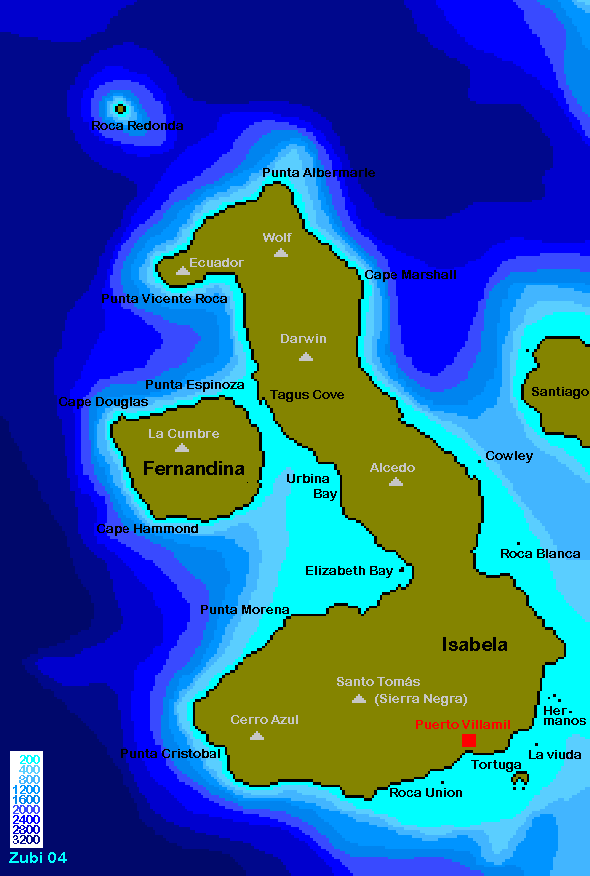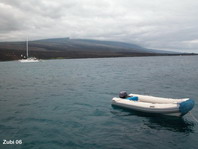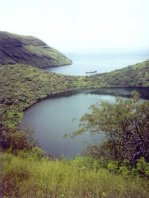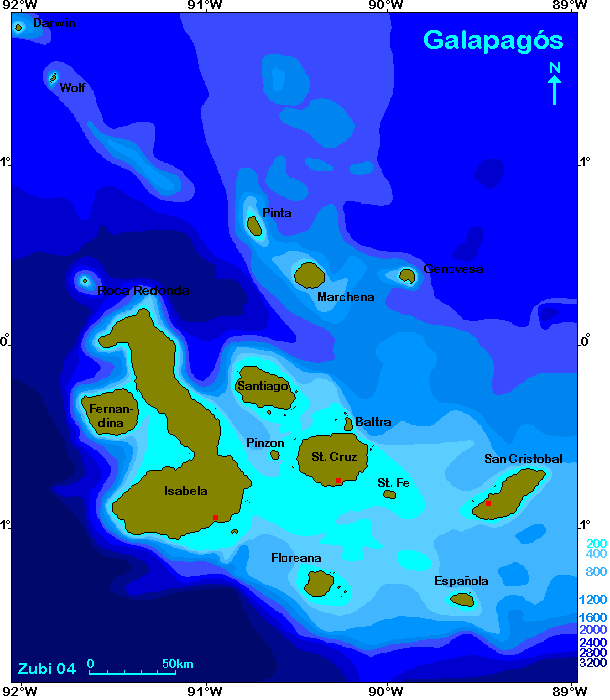Print version
of this page - Photos
taken in the Galapagos - Galápagos dive
info (dive operators, liveaboards, dive safety) - Galápagos maps
(print version - in
color) - Marine animals
seen underwater in the Galapagos (print version)
![]()
Cape Douglas - Cape
Marshall - Elizabeth Bay - Fernandina
- Isabela - Los
Hermanos - Punta Albemarle -
Punta Espinoza - Punta
Morena - Punta Vicente Roca -
Roca Redonda - Tagus
Cove - Tortuga
![]()
Isabela is with 4'670km² the largest island of the Galapagos. Most of the diving is done around the north coast (Cape marshall, Punta Albermarle, Punta Vicente Roca) and at Roca Redonda (on the trip north to Wolf and Darwin). On extended trips Fernandina island is also visited but I have heard that diving in some dive sites there are not permitted anymore. Puerto Villamil in the south of Isabela also offers some interesting dive sites around several small islands in the surrounding. The west of Isabela is directly in the path of the Cromwell current (see map), so there is a lot of upwelling cold water. Temperatures are around 20 to 24°C but can drop to 13 to 15°C (in El Niña years)! See Galapagos water temperatures
This area is specially interesting, since several fishes are more abundant here than elsewhere in the Galapagos islands because of the cold water, such as the Galapagos horned shark, the Galapagos rock bass (Camotillo), the goldrimmed surgeonfish, the harlequin wrasse or the sailfin grouper (Bacalao). Fernandina is very isolated and has endemic species seen nowhere else on the Galapagos, such as the flightless cormorant or - in the water -the endemic Galapagos Grunt (Orthopristis forbesi) and the White Salema (Xenichthys agassizi).
Isabela and Fernandina sit directly on the mantle hot spot and are geologically very active with 7 large volcanoes. Fernandina is one huge shield volcano with a large caldera and many lava flows. On Isabela there have been at least 13 eruptions since 1911, five of them at Cerro Azul and just 1998 a kilometer long crack opened and fountains of lava erupted to several hundred meters height, and three eruptions at Santo Tomas (Sierra Negra - black mountain) volcano in the south and five of them at the Wolf volcano in the north. Nasa satellite pictures 1, 2, 3 .
Galapagos
Geology on the Web - Alcedo
Volcano - Sierra
Negra
Global Volcanism Program: Alcedo
- Azul
- Darwin
- Ecuador
volcano - Sierra
Negra - Wolf

Click on the names to jump to the dive site (not all places
described)
Google Earth pictures: Fernandina - Isabela
- Punta Albemarle - Punta
Espinoza - Punta Vicente Roca
- Tagus
Cove (Detail) - Tortuga
/ Space radar images
Isabela
![]()
Roca Redonda is located off the northwest tip of Isabela Island, separated by about a 30km stretch of very deep water. This is the tip of a submarine shield volcano that rises nearly 3000m from the sea floor and emerges from the water as an island. The underwater area of this volcano is said to be about 18 kilometers wide. The island is about 300 meters high with steep cliffs and a flat top. Several lava flows can be observed on the island and in the shallow water and there are various caves. Seabirds live here, for example the swallow tailed gulls (Larus furcatus). These gulls are endemic to the Galapagos and the world's only night-feeding gull. It has unusual large eyes and feeds on squids that come to the surface, usually about 15-30km distance from the nearest land.
This dive site is visited either on the way up to Wolf and Darwin in the north or as part of a tour around Isabela. The water temperatures are very low here, because of the cold Cromwell current. Diving can be difficult because of the strong currents, unpredictable downcurrents, eddies and the heavy surge. If conditions are not right, your dive guide might advise you against diving. Want to know more about currents? Click here.
You dive around several underwater rocks and pinnacles always accompanied by sea lions. This is a good place to find schools of scalloped hammerheads, yellow tailed surgeonfishes, barracudas, jacks, Galapagos grunts and king angelfishes. Galapagos sharks and whitetips, mantas, and even the huge sunfish visit this remote place. With luck you can also find sea horses among the rocks in the shallows.
A special attraction is on the Southeast Side of the island. There are several underwater fumaroles (steam vents) in the shallows (12 to 18m) and you can see gas bubbles rising to the surface which indicate that the volcano is probably still active. I have visited a place similar to this in Siau, Indonesia, where there was hot sand and so many bubbles, it looked like a curtain, and found, that some species of marine animals grow much larger because of the abundance of some minerals. Anayway - it's also just interesting to touch hot rocks below the water and swim among bubbles...
The goldrimmed surgeonfish (Acanthurus nigricans or whitecheek tang / español: Pez cirujano de filo amarilla / Deutsch: Goldrand-Doktorfisch oder Samtdoktor) is mostly found around Isabela, Darwin and Wolf and is uncommon in the remainder of the archepelago. They are dark blue with a white tail and elongate white spot directly below eye. They inhabit clear lagoon and seaward reefs. They are herbivores and feed on filamentous algae. About 21cm. Fishbase- Fact sheet marine animals / Photos of this animal |
![]()
Punta Albemarle lies on the very northern tip of Isabela. Rocky volcanic cliffs drop down to the ocean floor as almost vertical walls. You might see large animals like manta rays, marbled rays, hammerhead sharks and marine turtles, but also Chevron barracuda, snappers, yellow fin tuna, rainbow runners, wahoo and groupers. There are also a lot of smaller fishes like creole fishes, parrotfishes, scrawled filefishes, pacific boxfishes and tiger snake eels. Google Earth pictures: Punta Albemarle
 Cape
Marshall (Puerto Egas) lies on the eastern side
of Isabela island. You dive where a huge lava stream from the Wolf volcano stopped
flowing into the ocean. The lava breaks off abruptly and forms a very steep
slope with boulders and lava ridges. Cover is sparsely with some black corals.
Dependig on the prevalent current you dive along either from north to south
or vice versa.
Cape
Marshall (Puerto Egas) lies on the eastern side
of Isabela island. You dive where a huge lava stream from the Wolf volcano stopped
flowing into the ocean. The lava breaks off abruptly and forms a very steep
slope with boulders and lava ridges. Cover is sparsely with some black corals.
Dependig on the prevalent current you dive along either from north to south
or vice versa.
This is a good place for mantas, mobula rays and eagle rays but also for the
occasional shark, yellowfin tuna and sealion. We saw several huge mantas close
by - one of them black on the top as well as on the belly - but the most impressive
sight was the school of mobula, probably at least 50 animals, that we met several
times. As we swam out into the blue, they were suddenly all around us, with
quick flips they sped past us and the whole school engulfed us, mobulas in front,
above, behind and on all sides! They stayed around, formed a more compact group
again and let us swim along for a while. A eagle ray which also joined us only
got a glimpse from us, we were so entranced from the mobula rays! Photos
of these animals
Some fishes encountered in Isabela - Fact sheet marine animalsInteresting are the schools of endemic black striped salemas (Xenocys jessiae / español: ojón / Deutsch: Grunzer / Fishbase) which are often found here. Salemas belong to the family of grunts. They can join in large, dense aggregations, most often over rocky slopes and protected areas. Other endemic fishes in the Galapagos / Photos of this animal Another fish endemic to the Galapagos is the white-spotted rock sea bass (Paralabrax albomaculatus / español: Camotillo / Fishbase), a sea bass with a row of white spots on the side. This fish is common here and around Isabela and likes cold water, so it is found mostly in areas of upwelling where it feeds on smaller fish. Length about 25cm. Another sea bass is the sailfin grouper (Mycteroperca olfax, español: Bacalao / Fishbase) which is common around the entire archipelago. While it usually is of a gray or brown color, it can also be bright golden yellow. These are known as bacalao rey (king bacalao). This is the economically most important fish in the Galapagos. They prefer open water near walls. Can grow to 1m long. Photos of groupers The Harlequin wrasse or Galapagos hogfish (Bodianus eclancheri / español: vieja mulata / Fishbase ) is an interesting looking multicolored wrasse. Not one fish looks like the other, they have various designs of orange, black, white and yellow. Most have a white chin patch and all a black spot at the base of the pectoral fins. Large adults have a distinctive bump on their forehead. They prefer cold water and are thus more common on the western islands. Another hogfish with a distinctive bump is the Mexican hogfish (Bodianus diplotaenia / Fishbase) which has longish fins and is gray to green-blue. The Zebra moray eel (Gymnomuraena zebra / español: morena zebra / Deutsch: Zebra Muräne / Fishbase) which is uncommon in the entire archipelago is also found here. This moray has an unique black and white color pattern which gives it its name. The snout of the zebra moray is very blunt with pebble-like teeth, so it can feed on large, heavily armored crabs and other crustaceans as well as snails and sea urchins. With the large crabs it will crush the claws and walking legs, with smaller crabs the entire animal. Hunts in reef crevices and rarely ventures out into the open. Length 88cm. |
![]()
Punta Vicente Roca lies at the northwestern point of Isabela close to the volcano Ecuador. There are two beautiful coves which lie on either side of the eroded remains of a volcanic cone. You start your dive on a shallow wall, that becomes a steep drop-off down to 50m. The wall is full of crevices and narrow shelves and is nicely covered with sponges and corals and you can find nudibranchs, crabs, slipper lobsters. There are several really interesting species of fishes living here, the red lipped batfish, frogfishes, seahorses, electric rays and the endemic camotillo. Here you can see schools of barracudas and salemas and even the occasional sunfish and marlin has been spotted here. Mostly drift diving. Night dives possible - good for crabs, shrimps and lobsters and other invertebrates. (In 2006 I heard night diving is not permitted anymore in the Galapagos islands). Google Earth pictures: Punta Vicente Roca
| An other uncommon fish you might see here with some luck is the endemic Galapagos bullhead shark (Heterodontus quoyi / español: gato / Deutsch: Galapagos Stierkopfhai), a bottom dwelling relatively small gray-brown shark with black blotches. It feeds primarily on shellfish, crabs and other crustaceans. This shark has a box-shaped head with a large ridge over the eyes and a sharp spine (horn) at the front of both dorsal fins. This shark is locally also known as Port Jackson horned shark, although the real Port Jackson shark (H. portusjacksoni) only lives in western Australia. Often seen at night. Also found further south at Tagus cove and Fernandina. Fishbase - shark foundation - other endemic fishes in the Galapagos There are two species of sunfish found in the Galapagos, the ocean sunfish (Mola mola / español: Pez luna / Deutsch Mondfisch) and the slender Mola (Ranzania levis). Punta Vicente Roca is one of the dive sites with sunfish sightings as well as Gordon's Rock, North Seymour, Española and the south of Isabela. The sunfish is the largest bony fish and can be up to 3m in length. I have seen this fish many times during the cold season in Lembongan, Bali, Indonesia, where it approaches the reef to get cleaned by angelfishes. The sunfish has a very unmistakable look with its eccentric roundish shape with huge fins but nearly no discernable tail and wont be mistaken for a shark or ray. More information on the sunfish. Fact sheet marine animals / Photos of this animal |
![]()
 Tagus
Cove: This is a large and deep bay on the western
side of Isabela with no beach. In the north, divided only by a small stretch
of land is the Darwin lake, which is a saltwater lake. There is a lot of upwellings
of cold water here, so temperatures can get very low (Galapagos water temperatures).
A lot of sponges and tunicates and non-reef building corals grow here and
there are plenty of the black coral bushes here (Antipathes galapagensis)
which hide animals like seahorses
(Hippocampus igens) and the longnosed hawkfishes (Oxycirrhites typus). Frogfishes
are also said to be seen here and stone scorpionfishes (Scorpaena mystes /
Pacific spotted scorpionfish) and player scorpionfishes (Scorpaena histrio)
have been found here. These are cryptic fishes which lie unseen on the reef
top waiting for small fishes to pass by. Their spines are highly poisonous.
Night dives possible (In 2006 I heard night diving is not permitted anymore
in the Galapagos islands). Google Earth pictures: Tagus
Cove (Detail)
Tagus
Cove: This is a large and deep bay on the western
side of Isabela with no beach. In the north, divided only by a small stretch
of land is the Darwin lake, which is a saltwater lake. There is a lot of upwellings
of cold water here, so temperatures can get very low (Galapagos water temperatures).
A lot of sponges and tunicates and non-reef building corals grow here and
there are plenty of the black coral bushes here (Antipathes galapagensis)
which hide animals like seahorses
(Hippocampus igens) and the longnosed hawkfishes (Oxycirrhites typus). Frogfishes
are also said to be seen here and stone scorpionfishes (Scorpaena mystes /
Pacific spotted scorpionfish) and player scorpionfishes (Scorpaena histrio)
have been found here. These are cryptic fishes which lie unseen on the reef
top waiting for small fishes to pass by. Their spines are highly poisonous.
Night dives possible (In 2006 I heard night diving is not permitted anymore
in the Galapagos islands). Google Earth pictures: Tagus
Cove (Detail)
| In Tagus Cove you can also find the largest species of asteroids in the world, Luidia superba or giant sea star. This five-armed starfish is over 1.2m large and preys on other starfishes. It hadn't been seen for several years and was rediscovered in 1974. The family of Luidiidae contains quite a lot of large sea stars with 5 to 15 arms. They usually burrow in sand. / Photos of other sea stars A weird looking fish which is found here is the red-lipped batfish (Ogcocephalus darwini / español: Pez murcielago labio rojo / Deutsch: Rotlippen-Fledermausfisch). As it's name suggests it has bright red lips and is about 17cm large. Walking batfishes have modified fins, that are used to walk (or rather hop) across the sea floor. They only swim occasionally and in a rather cumbersome fashion by spreading their pectoral fins. Like the frogfish (they also belong to the order of Lophiiformes) they have a modified first dorsal spine with a long rod (illicium) and an attached lure (esca). This rod is usually tucked into a depression above the mouth. Feeds on small invertebrates like crabs and mollusks. The snout of batfishes varies in shape and length, when they grow, it becomes smaller and more knob like. Red lipped batfishes usually live on sand, rubble or rocky bottoms from 3 - 76 m. Common in the entire Galapagos archipelago, active at night. Fact sheet marine animals - photos of the redlipped batfish |
![]()
South of Tagus Cove lies Urbina
Bay (or Urvina). This is not a dive site, but this place is interesting,
because in 1959 the coastal area was uplifted 5m above sea level in a matter
of hours. You can still see the remains of the marine animals that died, when
it happened, really large coral heads surrounded by plants! Elizabeth
Bay is a large sheltered bay with mangroves
in the very west of Isabela where Whale sharks have been sighted. They seem
to migrate south from Darwin and Wolf and pass this area in December / January.
Punta Morena
further down are rarely visited for diving, I have read, you can find the
Pacific seahorse here. The place is very impressive with large lava fields
from both Cerro Azul and Sierra Negra.
In the very south of Isabela are several dive sites situated close to Puerto Villamil: Los Hermanos (Crossman island) and Tortuga Island. This area is not very well known, there might be also some good diving around La Viuda and Punta Ventimilla in the north, Roca Union and Cabo Rosa in the south and around Roca Blanca in Cartago Bay even further north. Sunfishes have been reported from these waters. I heard there is a dive operator in Villamil, but couldn't find his address (write to me if you have more information!) Google Earth pictures: Tortuga
![]()
Since Fernandina lies to the very west of the Galapagos archipelago it has no introduced species, and as a consequence remains as the Galapagos were before being colonized. La Cumbre (the summit, about 1500m) is a highly active volcano with a large caldera and surrounded by several smaller craters. Most of the island is covered in lava flows, so there is not much vegetation. The island is surrounded by shallow rocky reefs that are covered in the green algae that is the only diet of the marine iguana. Fernandina geological information - Fernandina (Global Volcanism Program) - Google Earth pictures: Fernandina
There is only one dive site, Cape Douglas, because on Punta Espinoza which is located in the northeastern point of Fernandina island at the Bolivar channel between Isabela and Fernandina diving is not permitted anymore. The water here is cold all the time, since Fernandina lies smack in the zone of major upwellings from the Cromwell submarine current.
Some animals encountered in Fernandina - Fact sheet marine animalsOn Fernandina are large colonies of the endemic marine iguana (Amblyrhynchus cristatus / español: iguana marina / Deutsch: Meeresechse). Marine iguanas can get over a meter in length and can weight close to 9kg. They represent the only species of truly marine lizards. They are vegetarians and feed almost exclusively on marine algae. Marine iguanas are excellent swimmers, using their flattened tail and dive down to depths of 12m to nip the algal tufts from the rocks. It is amazing, that the thousands of iguanas (an estimate is of 250'000 animals, 7 subspecies) don't eat the rocks bare of algae. However the algae grow back quite fast, specially in the nutrient rich waters of the west. After diving the iguanas gather in large numbers and bask on the volcanic rocks so they can warm up in the sun. With the algae they ingest a lot of salt. They have adapted to this and have salt glands above each eye connected by a duct to the nostril. You can observe how the salt is literally sneezed out! / Photos of this animal There are 3 species of frogfishes in the Galapagos, Antennarius sanguineus (Bloody frogfish - pejerana bandeado), Antennarius avalonis (Roughbar frogfish - pejerana colorado), the small Antennatus strigatus (Bandtail frogfish - pejerana bocon) which all have been collected around Fernandina. Frogfishes are diffcult to find, because often they are perfectly camouflaged, showing the same colours as the sponges or the ground they sitting on. Frogfishes have converted one of the drosal fins into a lure. The lures mimic food animals like worms, small shrimps or small fish. The prey approaches to eat the lure and then is engulfed by the waiting frogfish. Frogfishes mainly eat fishes and crustaceans (shrimps and crabs). They can swallow items of prey that are twice as large as them. The endemic Galapagos grunt (Orthopristis forbesi / español: Roncador de Galapagos / Deutsch: Galapagos Grunzer) is rarely seen, but has been recorded on Fernandina. It has large silvery scales with dark markings. They school above rocky, boulder strewn reefs and slopes. Fishbase - other endemic fishes in the Galapagos - other endemic fishes in the Galapagos The endemic flightless cormorant (Nannopterum harrisi / español: cormorán áptero / Deutsch: Flugunfähiger Kormoran) is only found on the coastline of Fernandina and the northwestern shore of Isabela where the cold Cromwell current upwells. It is very large for a cormorant (about 90cm), brown with a long beak, very small wings and very large feet. It is the only cormorant in the Galapagos, and it is the only cormorant that has lost the ability to fly. The birds feed near the shore and near the bottom on squid, octopus, eel, and benthic fish. While diving for food it propels itself by powerful kicks of its large legs. When they return from a hunting trip offshore, they must open up their wings to dry them out. This looks a bit strange, since their wings are so small. It should be possible to see them underwater while diving, though I have heard, that you are not allowed to dive at some dive areas around Fernandina anymore. |
![]()

0-200m / 200-400m
/ then 400m-contour intervals to 3200m below sea
level
Click on the names to jump to the dive areas.
![]()
![]()
. Copyright Teresa Zubi